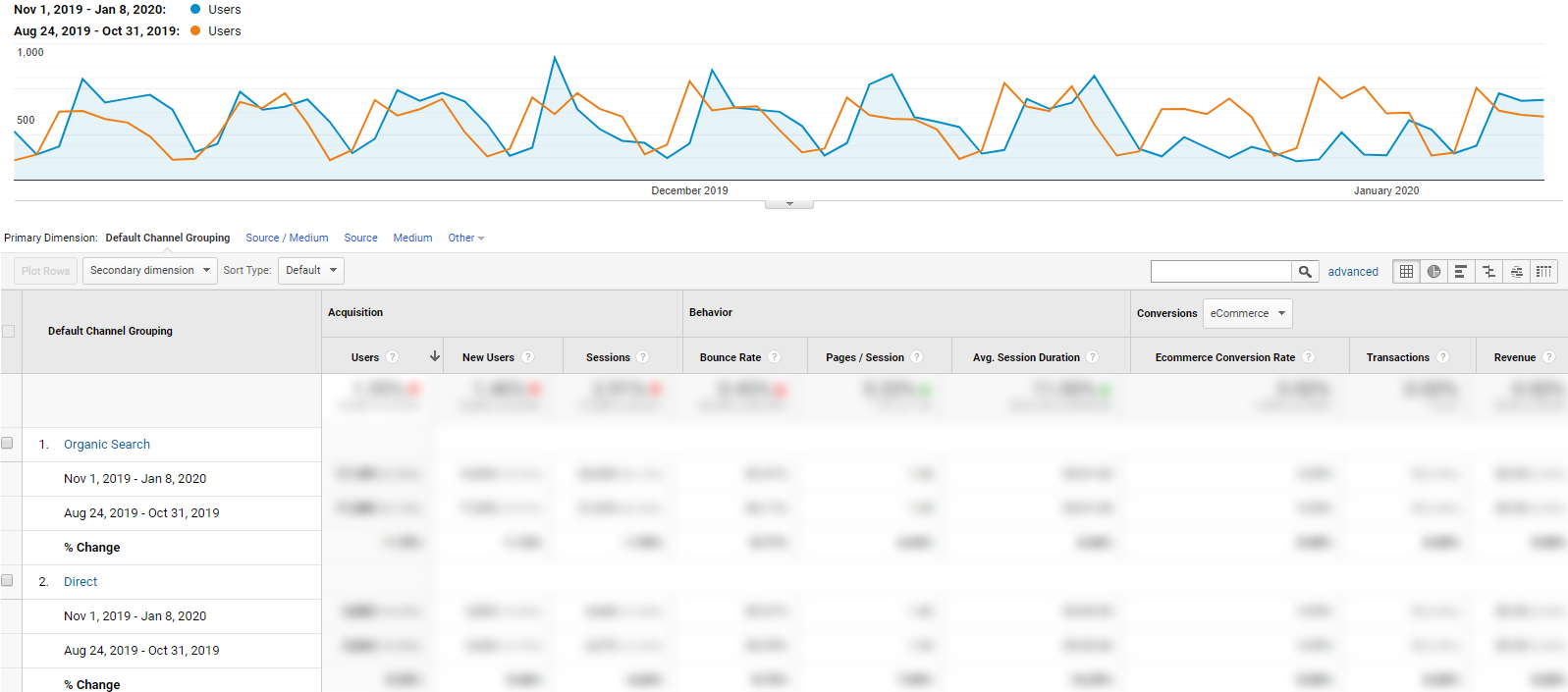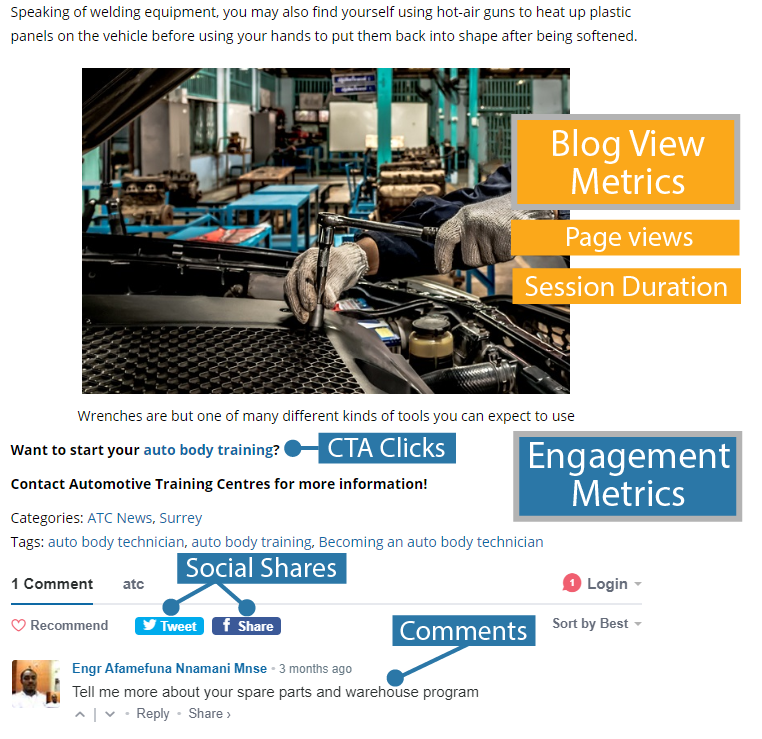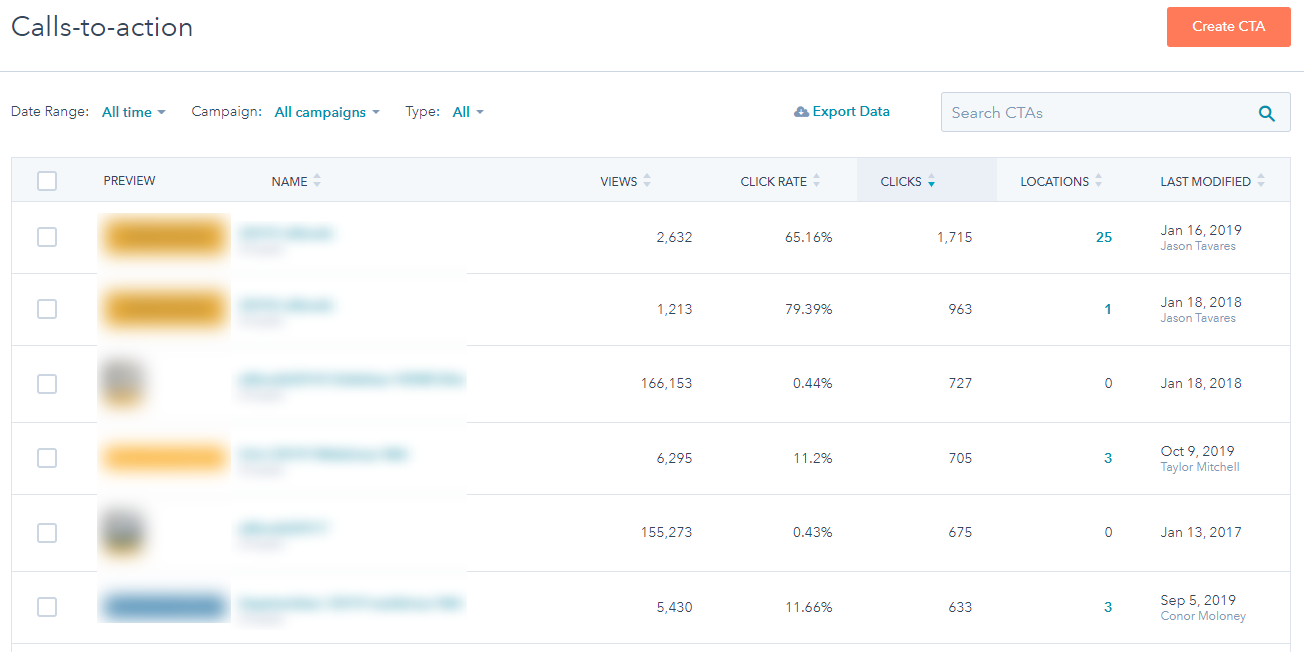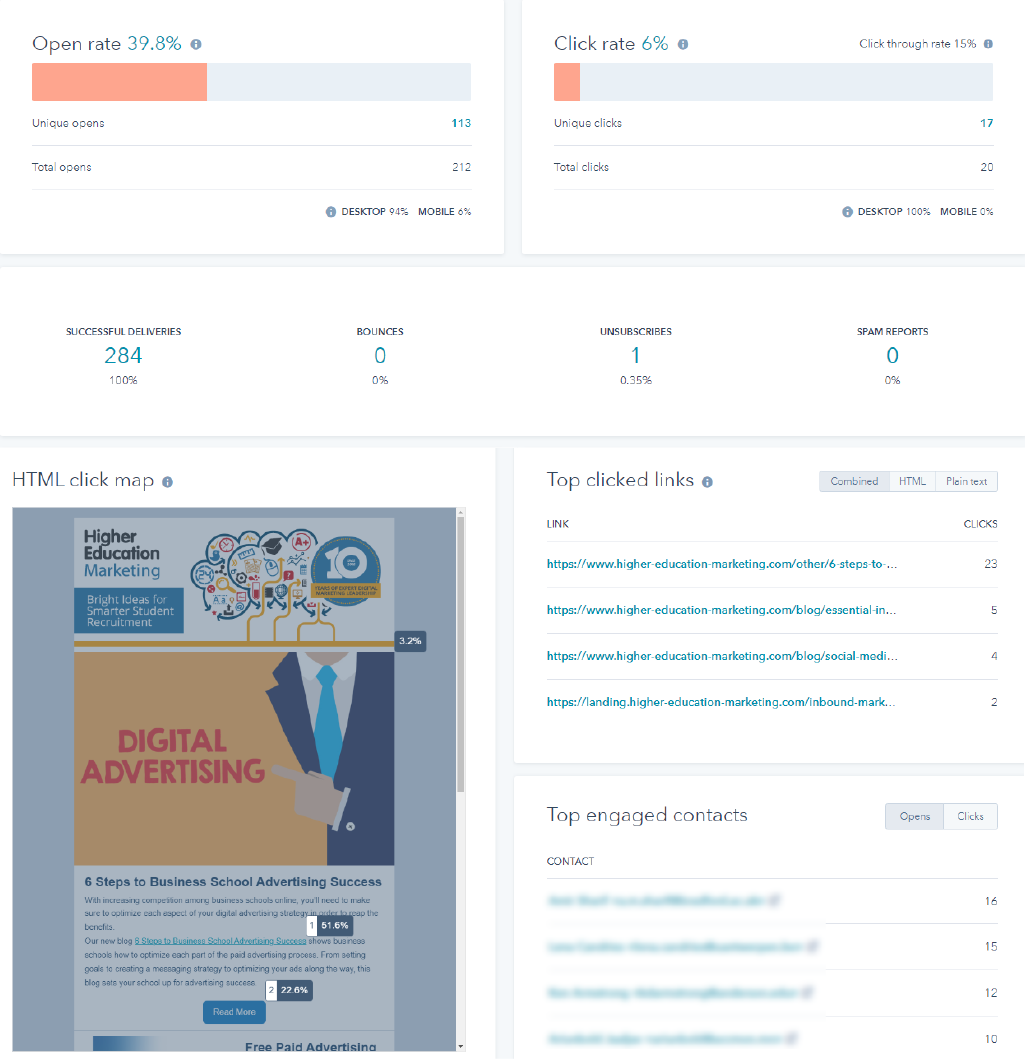
There’s no question that inbound is an effective marketing strategy for schools. After all, students need to trust their higher ed institution, and inbound marketing is all about building relationships with prospects. But perhaps what your school should be asking is whether its inbound strategy is as effective as it could be?
Luckily for schools, it’s easier now than ever before to answer that question. Each digital marketing channel offers a number of different metrics that you can use to analyze even the smallest details of your campaigns.
Curious to see the impact of your inbound marketing efforts more clearly? Read on to learn how!

SEO Inbound Marketing Analytics for Schools
If your school’s site isn’t seen by Google, how many prospects are going to be able to find you? The answer is: not as many as there could be.
That’s where search engine optimization (SEO) comes in. But before you can successfully optimize your web presence for search, you’ll need to analyze your school’s website data to see how it performs in relation to key search ranking factors.
Below are some common key performance indicators (KPIs) that many websites will use to evaluate their SEO performance. As you can imagine, the better these metrics are, the more visible your online presence will be, so it’s important to keep an eye on them.

Here’s a quick breakdown of what each of these metrics mean:
- Organic Traffic Growth: How much your organic web traffic has grown over a given period of time.
- Keyword Rankings: Where your web pages rank in searches for specific keywords.
- Conversions from Organic Traffic: The amount of web visitors who have converted on your website through organic search.
- Average Time Spent on Page: The average amount of time visitors on your site spend on an individual page. This can be measured as an overall average across your entire site, or for specific pages.
- Bounce Rate: The percentage of users who exit your site after landing on a web page without taking any further action (clicking a link, submitting a form, etc.).
- Top Landing Pages Attracting Organic Traffic: The pages on your site which attract the most traffic from organic search.
- Number of Indexed Pages: The number of pages which are indexed for search engine crawling.
- Link Growth: How many new links (both internal and external) have been added to your site over a given period.
The platform you host your website on will likely provide some of this data for you. But for in-depth KPIs such as keyword rankings and link growth, you’ll likely need to use third-party tools to obtain the level of detail you need.
This is especially the case for backlinks, which are simultaneously one of the most important metrics to pay attention to, as well as one of the most difficult to track. Backlinks occur when another website links to yours. These links signal to search engines that your site is a thought leader in the online community. Since these links aren’t generated on your website, they can be nearly impossible to measure without a tool like Moz, Backlink Watch, or SE Ranking.
Example: Moz allows you to see how many pages are linking to your school’s website, as well as the domain authority of the links. Although the more backlinks the merrier, you want to make sure they come from reputable sources – i.e. not from sites that are paid to link to others – otherwise you may risk being blacklisted on Google.

Another factor that influences your search ranking is the speed at which your pages load. It can be easy to get carried away with adding new elements to your web pages and miss the impact it may have on your loading speed, so it’s important for schools to continuously monitor this metric.
Example: With Google PageSpeed Insights, you can test your webpages to make sure they load within an appropriate timeframe. As you can see, this page is performing moderately well, but there’s definitely room for improvement.

Since your SEO strategy should ultimately result in an increase in inquiries and applications, it’s also important to understand the role that organic search plays in generating conversions for your school.
Example: The GA Channel Report offers many useful metrics into how well your website is converting visitors, such as conversion rate, the number of transactions you’ve made – which, in the case of schools, can refer to bookings, tuition payments, application fees, and more – as well as the overall revenue you’ve generated.

Monitoring the Performance of Higher Ed Content
Creating content is a top priority for inbound marketers. Blog posts, infographics, videos, and other forms of content offer students relevant and helpful information – which fulfill a primary goal of inbound marketing for higher education.
However, schools shouldn’t simply be producing content for content’s sake – it should also drive prospects down the enrollment funnel. By measuring the right metrics, you can assess how well your content fulfills this objective.
But unlike an inquiry form, which has a clear conversion outcome, how can a school find out the impact of, let’s say, a blog post?
Well, it’s not all that different from using the SEO monitoring tricks mentioned earlier – except there are some specific KPIs you can follow in order to best evaluate blog success, as demonstrated below:

For starters, analyzing page views and comparing them between blogs is a great way to gauge general interest in your content. The number of views a blog has relative to your other posts is a great way to see which topics are most intriguing, or what kind of title invites the most clicks.
Initial interest is one thing – but to learn how your content sustains a prospect’s attention, you’ll need to look at other inbound marketing analytics. Average session duration, for instance, shows schools the average length of time a user spends reading your blog before navigating away.
Then, to see which users are really engaged, you can look at metrics like social shares and comments. (While you’re at it, this is a great time to reply to any outstanding comments on your posts.)
But perhaps the most important form of engagement on your blog – or any form of content for that matter – is CTA clicks. Since CTAs usually bring users to a lead-generating offer, it’s important to keep an eye on how many people are clicking on the key links in your blog.
Example: HubSpot provides in-depth insight into your CTA performance, including the click rate, which measures the percentage of people who click the CTA out of those who view it.

It’s also useful to compare different CTA click rates in order to see which offers are most appealing, and which you may need to frame differently in order to attract more clicks.
Example: Inline CTAs are located at the end of all blog posts from John Cabot University. Some, like the first, direct users to a specific program, while the second links to a more general application page. By monitoring and comparing these CTAs, you gain valuable insight into the impact of your blogs on applications and inquiries.

On the other side of the content metrics coin is bounce rate, which shows how many users didn’t click any of your CTAs or links and instead exited your site altogether. Taken together, bounce rate and CTA clicks will give you a good idea of the proportion of prospective students you’ve successfully moved down the admissions funnel with each blog post.
Social Media Analytics for Schools
Almost every school is using social media as part of their inbound marketing strategy, but much fewer are regularly managing their social performance. Without keeping a keen eye on the data, you won’t know how best to improve your presence on key social platforms – and may be missing out on reaching a wide range of prospective students as a result.
From more surface level KPIs to conversion metrics, there are many different social media statistics you can use to improve your strategy for each stage in the admissions funnel.
If you want to generate more awareness of your school on social media, monitoring your posts’ reach and impressions will show you what kind of content has the widest appeal for your school.
Example: On the Insights tab of Instagram, you can easily analyze and compare the impressions your posts receive.

However, this metric doesn’t necessarily provide insight into the quality of users you’re reaching. After all, just because someone comes across your post doesn’t necessarily mean that they’re interested in your school.
With that being said, engagement metrics are key inbound marketing analytics for schools to measure because they highlight how many social media prospects you have at the middle of the funnel.
As mentioned in the content creation section, comments are a key metric to measure, as are other reactions such as Likes and Shares. But there are a whole host of other social media KPIs out there to measure, and they differ based on channel:

If you want to see how many people really like your posts, then take a look at your follower count. This KPI will show you how many prospects decided they liked your content – or better yet, your school – enough to want to keep up with your posts.
As for the bottom of the admissions funnel, it’s important to evaluate the correlation between your social media presence and the inquiries and applications your school receives by looking at how many leads you generate from social.
This kind of metric is not one you’ll be able to find on the native insights platform on each social media channel – but GA, marketing automation, and other types of software can find that information for you.
Example: This report from HubSpot, a popular CRM, shows the various channels that a school’s leads were generated from over a set period of time.

When analyzing conversion-based social media metrics, you may notice that social media may not generate as many leads as, say, organic search – but that doesn’t mean it’s not an integral part of your inbound marketing strategy.
Social Media plays a big role in building a strong online reputation and curating an image of your school that students will take note of, and it can also be an effective vehicle for generating leads – but getting to that point requires consistent data analysis and regular optimization. The better you understand social metrics, the easier it will be to reach your social media goals using inbound marketing for schools.
Higher Ed Email Marketing Metrics
Considering that 73% of millennials would rather businesses communicate through email, email marketing proves itself as a top inbound channel for the education sector’s most common target demographic.
However, making the most out of email marketing isn’t easy. Even the number of words – and the kinds of words you use – in your subject lines can have a tremendous impact on the amount of prospects that open your messages. That’s where KPIs come in, helping schools pinpoint exactly what works, and what needs to be changed, in order to gain more traction via email.
Let’s start with the metric that is measured when leads first encounter your email: the open rate. As the name suggests, this KPI lets you know how many prospects actually opened your email. But simply knowing the open rate doesn’t do much if you don’t have something to benchmark against, so keep in mind that the average email open rate in the education industry is 23.4% and set goals accordingly.
When analyzing open rate, schools should also know that some email providers – like Outlook, for instance – automatically open messages, so this metric may not always be fully indicative of which leads are interested in your mails.
As a result, it’s crucial for schools to keep track of email click rate and click-through rate (CTR). Click rate shows you how many prospects were compelled enough to click on one of the links or CTAs in your message – an action which usually guides them further down the admissions funnel. If you divide this number by the amount of people that opened your email, then you’ll get the CTR.
Example: Through HubSpot, you can assess these metrics – and more! – for each email you send. If you’ve got multiple links in the email, you can also see which ones attracted more clicks. HubSpot also calculates which of your contacts are most engaged with your emails, making it easier to prioritize interested leads in your follow-up process.

As with every digital marketing channel, you’ll also want to assess the overall impact your email marketing efforts have on your recruitment strategy. To do so, you can analyze how many leads were generated through email – a metric we mentioned before – as well as take a look at your email marketing ROI.
To calculate this, look at how much time and money you’re devoting towards your email campaigns, as compared to the worth of the leads you’ve generated. Marketers say that $38 is generated from every $1 spent on email marketing, so if your ROI is in this range, then you’re on the right track.
Measuring the Overall Success of Inbound Marketing for Schools
Once you’ve got a good grasp on how each of your inbound marketing channels are performing, it’s time to tie it all together and assess the total impact of your inbound strategy.
Are your enrollment numbers where you’d like them to be? Is your lead flow increasing at the rate you want? Perhaps you’ve just created a new resource like a quote builder or career quiz and you want it to play a bigger role in recruitment. These are the different things you can set as aptly named ‘Goals’ in Google Analytics in order to easily track their progress on an ongoing basis.
Depending on what kind of digital marketing goals you have, Google Analytics can help give you a better grasp on how your inbound strategy has helped you achieve them. Navigate to the ‘Conversions’ tab in GA and select ‘Goals.’ There, you can monitor your different goals from various angles, such as completion, conversion, abandonment rate, and goal value:

Once you start paying close attention to data, it can be easy to get caught up in the details, but monitoring your overall inbound goals will help you maintain a big picture outlook while analyzing more micro-level KPIs such as email clickthrough rates or social media followers. That way, you’ll be able to optimize and improve each of your inbound marketing channels with your target objectives in mind.






